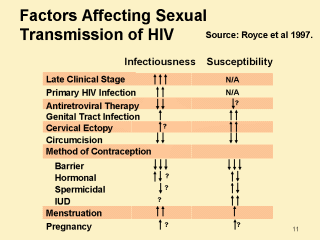 |
There are
several factors that increase or decrease the risk of sexual transmission of HIV. For
example, individuals who are newly infected with HIV or who have AIDS are more infectious
because they have higher levels of virus in their blood and genital secretions.
Antiretroviral therapy lowers the amount of virus in an infected individual and therefore
reduces the risk of transmission. STDs, both ulcerative and nonulcerative, increase both
infectiousness and susceptibility to HIV approximately 2–5 times. Uncircumcised men
appear to be at increased risk of transmitting and acquiring HIV. When a woman is
menstruating, pregnant or has cervical ectopy, she may have an increased risk of HIV
transmission. Barrier contraceptive methods, including the male and female condom, provide
the greatest protection against both transmission and acquisition of HIV. The role of
hormonal contraceptive methods in HIV transmission is inconclusive, although some data
suggest that they may increase genital tract HIV shedding. Although spermicides (most of
which use nonoxynol-9 as the spermicidal agent) have activity against HIV in the
laboratory, a recent clinical trial conducted by UNAIDS in Africa and Thailand in sex
workers who averaged over 3 partners daily found significantly increased rates of HIV
seroconversion in nonoxynol-9 users as compared to placebo. Finally, the IUD was
associated with increased susceptibility to HIV transmission in an Italian cross-sectional
study, but not in prospective studies. |
